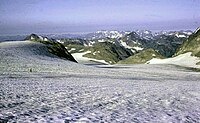
Photo from wikipedia
Abstract During the Last Glacial Maximum (LGM) the marine-terminating Barra Fan Ice Stream (BFIS), a major conduit of the British Irish Ice Sheet (BIIS), drained much of western Scotland and… Click to show full abstract
Abstract During the Last Glacial Maximum (LGM) the marine-terminating Barra Fan Ice Stream (BFIS), a major conduit of the British Irish Ice Sheet (BIIS), drained much of western Scotland and northwest Ireland with ice streaming onto the continental shelf of the Malin Sea. The extent and retreat history of this ice stream across the shelf, until now, is not well known. In particular, geochronological constraints on the history of this ice stream have thus far been restricted to deep-sea cores or terrestrial cosmogenic nuclide dating onshore, with ages across the shelf absent. To understand the possible external forcing factors acting on this marine terminating ice stream during retreat, improved geochronological constraint on its deglaciation is necessary. Here, we present new geophysical data, marine sediment cores and over forty radiocarbon dates to provide important constraints on maximum extent of the BFIS, as well as the timing and pattern of retreat back across the Malin Shelf. Dated moraines and grounding-zone wedges (GZW) seen in seafloor sub-bottom profiles provide evidence that the BFIS reached the Malin Shelf edge during the LGM and was at its maximum extent around 26.7 ka BP. The presence of two sets of GZWs suggests that the style of retreat was episodic. The new radiocarbon chronology shows that retreat from the shelf edge was underway by 25.9 ka BP, with the majority of the continental shelf ice free by 23.2 ka BP, and that glacimarine conditions were present in the Sea of Hebrides by 20.2 ka BP at the latest. Collectively, these results indicate that the majority of the Malin Shelf was free of grounded ice by ∼21.5–20 ka BP, which is up to 4000 years earlier than previously reconstructed. We attribute this early deglaciation to high relative sea level caused by glacial isostatic depression when the BIIS reached its maximum extent promoting ice shelf and grounding line instability. Two deep troughs, forming reverse bed slopes, aided the continued retreat of the BFIS. This suggests that local ice loading and bed morphology can be significant controls on the destabilisation of a marine-terminating ice stream and can override the influence of ocean and atmospheric temperatures.
Journal Title: Quaternary Science Reviews
Year Published: 2018
Link to full text (if available)
Share on Social Media: Sign Up to like & get
recommendations!